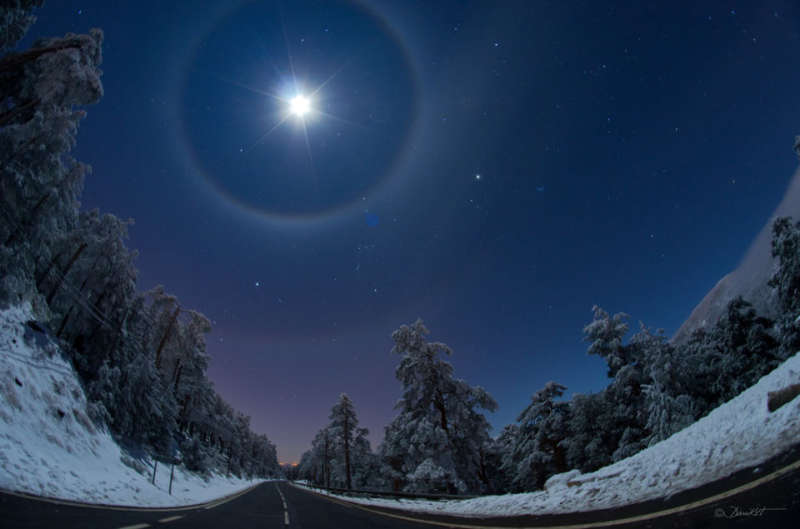Credit & Copyright: Dani Caxete
Explanation:
Sometimes falling ice crystals make the atmosphere into a
giant lens causing arcs and halos to appear around the Sun or Moon.
This past Saturday night was just such a time near
Madrid,
Spain,
where a winter sky displayed not only a bright Moon but
as many as four rare lunar halos.
The brightest object, near the top of the above image,
is the Moon.
Light from the Moon
refracts through tumbling
hexagonal ice crystals into a
22 degree halo
seen surrounding the Moon.
Elongating the 22 degree arc horizontally is a
circumscribed halo caused by
column ice crystals.
More rare, some moonlight refracts through more distant tumbling ice crystals to
form a (third)
rainbow-like arc 46 degrees from the Moon and appearing here
just above a picturesque winter landscape.
Furthermore, part of a whole
46 degree circular halo
is also visible, so that an extremely rare -- especially for the Moon --
quadruple halo
was actually imaged.
The snow-capped trees in the foreground line the road
Puerto de Navacerrada in the
Sierra de Guadarrama
mountain range near Madrid.
Far in the background is a famous winter skyscape that includes
Sirius, the
belt of Orion, and
Betelgeuse all visible between the inner and outer arcs.
Halos and arcs typically last for minutes to hours,
so if you do see one there should be time to invite family, friends or neighbors
to
share your unusual lensed vista of the sky.
Quick Poll:
Have you ever seen a lunar halo?
1999 2000 2001 2002 2003 2004 2005 2006 2007 2008 2009 2010 2011 2012 2013 2014 2015 2016 2017 2018 2019 2020 2021 2022 2023 2024 2025 |
Yanvar' Fevral' Mart Aprel' Mai Iyun' Iyul' Avgust Sentyabr' Oktyabr' Noyabr' Dekabr' |
NASA Web Site Statements, Warnings, and Disclaimers
NASA Official: Jay Norris. Specific rights apply.
A service of: LHEA at NASA / GSFC
& Michigan Tech. U.
|
Publikacii s klyuchevymi slovami:
galo
Publikacii so slovami: galo | |
Sm. takzhe:
Vse publikacii na tu zhe temu >> | |
